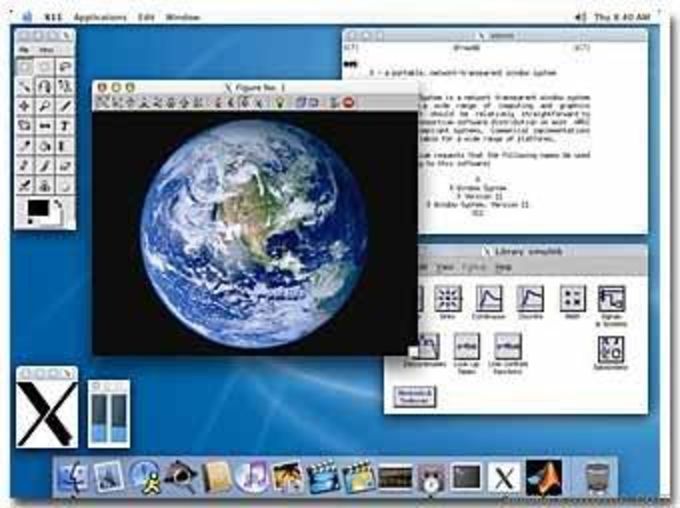X11 for Mac OS X offers a complete X Window System implementation for running X11-based applications on Mac OS X. Based on the de facto-standard for X11, the open source XFree86 project, X11 for Mac OS X is compatible, fast and fully integrated with Mac OS X. It includes the full X11R6.6 technology including a window server, libraries and basic. MacOS Catalina 10.15.7 Supplemental Update 2. MacOS Catalina 10.15.7 supplemental update addresses an issue that may prevent the battery from charging in some 2016 and 2017 MacBook Pro models. X11 Forwarding in Linux/Mac OS X – For Macs, your best option is to download xQuartz from xQuartz.org.This is free software which will allow you to forward X11 on a Mac. Download the xQuartz DMG, open it, and follow the installation instructions.
Install X11 and X11 SDK components. Both are available on your Mac OS X CD. However, X11 itself is also available as a download (Panther compatable download here ) from Apple. Jun 29, 2011 Instructions for Installing MGLTools on Mac OS X. X11 can typically be found on the Mac OS X installation DVD. Scroll down in the 'Mac OS X Install disc' window and locate 'Optional Installs'. Double click to start the Installer, at the 'Installation Type' stage open the Applications category, select X11 and proceed.
NOTE I don't have a Mac to easily test and amend these instructions, but it has been tested through Travis Continuous Integration tool and a lot of people managed to get it working. If anyone wants to edit the wiki with better and more up to date Mac instructions please do!
Prerequisites
I recommend installing Homebrew as the easiest way to get a variety of Open Source libraries. Think of it as the Mac equivalent of
apt-get. Homebrew usually installs things under/usr/local/Cellarand then creates links to the version you're using in/usr/local/bin,/usr/local/libetc. This will be relevant later.Install C++17 compiler, boost, TBB, dlib, OpenBLAS, and OpenCV, wget (for model download) with:
The landmark detection model is not included due to file size, you can download it using the bash
download_models.shscript. For more details see - https://github.com/TadasBaltrusaitis/OpenFace/wiki/Model-acquisitionYou'll want the Command Line Tools for Xcode. If you can't use these for any reason, you can build
gccusing Homebrew -- in fact, it will happen automatically -- but it'll be much slower.Get XQuartz (an X Window system for OS X). You don't actually need it to run OpenFace, but having the X libraries and include files on your system will make OpenFace (and various other things) much easier to build.
Optional, but you may find it useful to tell CMake how to find your X Windows libraries, since they may not be in the same place as expected on Linux. Add the following lines to CMakeLists.txt (e.g. after the similar section for OpenCV):
Install X11 Library Mac Torrent
Building
After that, the build process is very similar to Linux (in OpenFace directory execute the following).

and you should have binaries in the bin directory. e.g. you can run:
OpenBLAS performance
OpenFace uses OpenBLAS to accelerate numerical computations and TBB for parallelization, in some cases the threading of OpenBLAS and TBB clash. This can lead to the following error:OpenBLAS : Program will terminate because you tried to start too many threads.
To fix it and to potentially improve OpenFace performance:
You can add the below environmental variables (run in the shell just before running any of the OpenFace executables):
You can reinstall OpenBLAS with openmp:

Also see this thread: https://github.com/TadasBaltrusaitis/OpenFace/issues/748
- Manually Installing an Oracle® Solaris 11.4 System
- Document Information
- Using This Documentation
- Chapter 1 Overview of Installation Options
- What's New in Installation for Oracle Solaris 11.4
- Installation Methods and the Installation Documentation
- Additional Installation Options
- System Requirements for OS Installations
- About IP Addresses in This Guide
- Chapter 2 Preparing for the Installation
- Using Rights Profiles to Install Oracle Solaris
- Partitioning Your System
- About Partitioning for Installing Multiple Operating Systems
- Partitioning a System Prior To Installation
- Partitioning a System During an Interactive Installation
- x86: Setting Up Partitions During an Interactive Installation
- Setting Up VTOC Slices During a Text Installation
- Installing on a SCSI Target
- About Device Drivers on the System
- Chapter 3 Using the Text Installer
- About Text Installation
- Text Installation Tasks
- Adding Software After a Text Installation
- Appendix A Text Installer Panels
- Panels for Configuring the Installation
- Appendix B Using the Device DriverUtility
- Device Driver Utility Overview
- Index
X11 is a remote-display protocol used by Linux/Unix machines, including the Linux machines at Thayer. By running an X11 program (known as a server) on your computer, you can access graphical Linux programs remotely through an SSH client. In addition some *nix applications ported to macOS do not run natively under the macOS GUI and require X11.
Terminology Note: The program displaying graphics on your local machine is called an X Server, and the process on the remote end is called an X client. Yes, this may be backwards from what you might first expect. You can think of this program providing local graphics services for client programs running remotely.
Windows
- Xming Open-source, free, and full-featured.
macOS
To install X11 on macOS, download and install the XQuartz Application from: www.xquartz.org

FastX
Mac Os X X11
Another method for accessing graphical programs remotely from our Linux compute servers is FastX. This program allows you to run a full remote desktop which can be disconnected and reconnected while graphical applications continue to run. FastX can also be much faster that X11 forwarding, especially over slower connections. For more information about downloading and setting up FastX, see this page: FastX